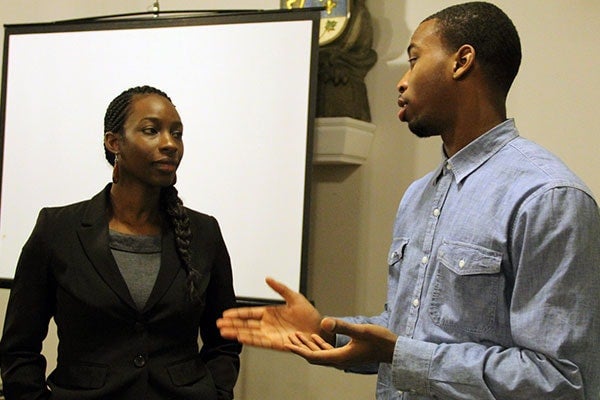
Dissecting race, education and sport
Published: January 29, 2014
In the world of university sport, there can be challenges that shape the student-athlete experience for racialized players. For third-year kinesiology student and Varsity Blues volleyball player Nathaniel Virgo, these subtle differences were felt even before he stepped on the court.
“I remember the first day I came to the University on an orientation tour,” said Virgo. “A girl walked up to me right away and asked if I was a recruit for the basketball team. Already, I was up against the assumption ‘you’re tall, you’re black, and you’re at the University of Toronto…why else would you be here?’”
Virgo was one of five panelists who gathered at Hart House on January 22 to take part in “A Hurdle to Success: The Path for Pan Am/Parapan Am Legacy,” the first in a series of panel discussions that will explore the intersections between race, sports and post-secondary education.
“We know that sport is considered an important means of access to post-secondary education for racialized and indigenous youth,” said moderator Janelle Joseph, an alumna from U of T's Faculty of Kinesiology & Physical Education who is now a Banting postdoctoral research fellow at the University of Ontario Institute of Technology. “Through these discussions, we’re hoping to galvanize the Ministry of Education, government, and policy-makers to move university sport in a direction that makes change for these student-athletes.”
Racialized students’ access to university sport was a recurring theme throughout the night. As panelist Jason Sealy, assistant coach with the Ryerson Rams basketball program, pointed out, a lack of finances, information and/or support is an issue that disproportionately affects racialized student-athletes.
“I look at these things as currency,” said Sealy. “In my experience as a coach, a lack of this currency negatively affects the chances of racialized students being recruited.”
In a time where many universities recruit not from high schools but from athletic clubs, racialized students from low-income neighbourhoods face a financial barrier to intercollegiate sport. For others, a lack of information shuts them out of university athletics as early as grade nine. Sealy, as well as Blues head football coach Greg Gary, agreed that too often, racialized youth are placed in applied secondary school programs that ultimately render them academically ineligible to apply for university.
“We have to make sure that young people know what it actually takes to make it to university,” said Gary, a former NFL linebacker who attended California State University, Fullerton, on an athletic scholarship. “We need to expose kids to the university community and look at this as a long-term investment.”
While access proves to be a barrier for many racialized students, others who make it through the recruitment process face obstacles once they join a team.
“Nobody knew I was Aboriginal until I was well-entrenched in the university sports system,” said Janice Forsyth, assistant professor and director of the International Centre for Olympic Studies at the University of Western Ontario. “When I let people know I was Aboriginal, things certainly changed. There’s racism – both overt and subtle that can exist among team members and staff.”
Gender barriers, as well as challenges balancing sport and academics were also identified as issues racialized student-athletes encounter. The panel members agreed that a pre-emptive approach is the best way to find solutions to these challenges.
“Aspiring athletes, their parents, and their influencers need to have a clear idea of the pathways to university sport,” said Sealy. “This outreach needs to happen earlier than high school, so that the youth can create as many options for themselves as possible.”
And who better to reach out to an aspiring student-athlete than someone who is experiencing the world of university sport for themselves? Virgo says he believes that current student-athletes are the best ambassadors to inspire youth:
“When I was in elementary school, I didn’t listen to my parents or teachers…I listened to the older kids in the neighbourhood,” said Virgo. “We have to send our athletes to neighbourhoods and spend some time talking to kids. We have to let kids know that there is life beyond high school and teach them how to prepare.”
Adrienne Harry is a writer with the Faculty of Kinesiology & Physical Education at the University of Toronto.



